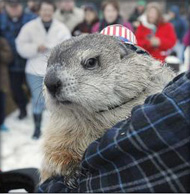
Thousands will gather in Gobbler’s Knob, Punxsutawney, Pennsylvania, on Feb. 2, Groundhog Day, to watch as the world’s most famous weather wizard makes his annual prediction. As he emerges from his burrow, television stations around the world will broadcast his movements.
According to tradition, after Phil emerges from his burrow on Feb. 2, he speaks to the Groundhog Club President in “groundhog-ese.” The president then translates the proclamation for the world.
If Phil sees his shadow, it’s a sign of six more weeks of bad weather. If not, we can expect an early spring.
Groundhog Day has its origins in the ancient Christian tradition of Candlemas Day, a day on which clergy would bless and hand out candles needed for winter. The candles symbolized how long and cold the winter would be. Germans expanded this tradition by choosing an animal, the hedgehog, to predict weather. The tradition was carried to America, and German settlers changed the animal to the groundhog when they made their homes in Pennsylvania.
Punxsutawney Phil has been predicting the weather for decades. Groundhog Day in the United States dates back to the late 1800s, with the first official trek to Gobbler’s Knob documented on Feb. 2, 1887.
Phil’s supporters claim he’s accurate 75 to 90 percent of the time, but some weather experts claim Punxsutawney Phil is no meteorologic mystic. According to the StormFax Weather Almanac and records kept since 1887, Punxsutawney Phil’s weather predictions have been correct 39 percent of the time. The National Climatic Data Center, previously known as the National Weather Records Center (NWRC), in Asheville, N.C., has described the forecasts as “on average, inaccurate” and stated that “[t]he groundhog has shown no talent for predicting the arrival of spring, especially in recent years.”
FUN FACTS ABOUT GROUNDHOGS
- A groundhog (Marmota monax) is also known as a woodchuck, whistle-pig, and a land-beaver. The name whistle-pig comes from the fact that a groundhog, when alarmed, will emit a high-pitched whistle as a warning to the rest of its colony.
- Groundhogs are some of the few true hibernators. They fatten up in the warmer months, primarily eating wild grasses and other vegetation. They also eat grubs, grasshoppers, insects, snails and other small animals. Then, they go into a deep sleep – more like a deep coma – for up to three months of cold weather.
- During hibernation, a groundhog’s body temperature can drop from about 99 degrees down to 37 degrees, and its heart rate drops from 80 beats per minute to five.
- A groundhog loses no more than 25 percent of its body weight during the long sleep, due to all the energy saved by the lower metabolism.
- Groundhog babies – called kits or cubs – are usually born in mid-April or May. There are usually four to nine kits in a litter, and by July, they’re usually off on their own. (Sometimes the female kits will stick around until the following spring, when the next litter is due.)
- Groundhogs eat a lot during warmer months – up to a pound of vegetation in one sitting (which is a fair amount for a roughly 12- to 15-pound animal).
- A groundhog digs a burrow in the ground, which can be as much as six feet deep. It can be 20 feet or more long, and usually has 2 entrances but more often as many as 12. This is particularly helpful in steering clear of enemies; after all, the groundhogs top speed is only about 8 mph. (Among its predators are some pretty fast animals: a fox can run up to 30 miles per hour; a coyote, 60 mph.)
- Groundhogs can also swim and climb trees.
- The February exit from a den is not based on the groundhog’s desire to predict the weather. In fact, males emerge in early February to wander their two- to three-acre territories in search of females’ burrows. Research indicates this is just a “getting to know you” visit. Breeding doesn’t take place until March, when they emerge from their den for good.
- Groundhogs are solitary animals, with the exception of females and their young.
Copyright ©2015 by Parent Today and Capital Region BOCES; Used with permission
 Skip to Content
Skip to Content Capital Region BOCES
Capital Region BOCES


